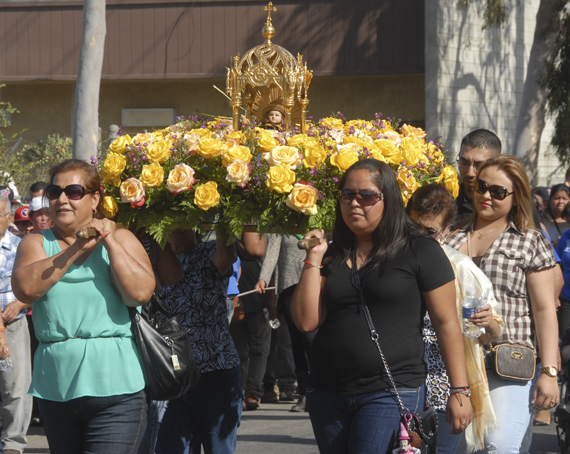
|
Bands played lively tunes as people cheered the return of El Santo Niño de Atocha to Santa Paula’s Our Lady of Guadalupe Church Saturday. The Holy Child was nestled on a bed of yellow roses as he was carried during Saturday’s procession.
|
El Santo Niño de Atocha: Joyous arrival for icon visiting Santa Paula
June 04, 2014
By Peggy Kelly
Santa Paula News
The long procession included colorfully costumed Aztec and other dance troupes from throughout Mexico, Southern California and the western states; there were proud equestrians - some garbed as traditional vaqueros - astride gorgeous horses, the dancing black Friesians reflecting the joy of the swelling crowd.
Bands played lively tunes as people cheered the return of El Santo Niño de Atocha to Santa Paula, The Holy Child distinctly characterized by a basket on his arm, along with a staff, drinking gourd, and a cape with the shell symbol of a pilgrimage to Saint James, all nestled on a bed of yellow roses carried during Saturday’s procession.
Thousands of people started gathering early at Harding Park and along the parade route that ended at Our Lady of Guadalupe Church on North Oak Street.
There were hundreds in the procession including dancers young and old, or at least made up to look old, as it would have taken miraculous stamina to dance the long route on the warm Saturday afternoon.
Mariachis in colorful pink shirts played from the back of a pickup and a glittered banner of Our Lady of Guadalupe were also part of the procession that traveled on streets closed throughout the city.
The dance troupes all wore costumes although some were more elaborate than others: The Kings wore full heavy masks with carved beards while other “danzas” sported headdresses and feathers, leggings and moccasins.
As the sun grew hotter one rider thoughtfully refreshed his horse by pouring the contents of a water bottle on its forelock and mane, a move that delighted the steed that shook his head to distribute the wetness.
Young girls gaily dressed in traditional finery were also astride fine steeds as were boys not tall enough to reach saddle stirrups.
But it was the doll of The Holy Child of Atocha, nicknamed El Niño Azul because its usual garb is blue that captured the crowd’s attention.
The depiction of the miraculous Christ Child is the Catholic Church’s third-most cherished religious icon in Mexico that each year brings thousands of visitors to Santa Paula.
El Santo Niño is on loan from its shrine in Plateros, Mexico; being enshrined in Santa Paula will allow visits by pilgrims who cannot travel to Plateros to visit the original icon.
Once the icon leaves Our Lady of Guadalupe Church, El Santo Niño de Atocha will travel to the Mid-West.
Many in Saturday’s crowd were holding onto elaborate dresses made for The Holy Child; such costumes will be brought to the church daily for the doll to be changed into including those made by visitors from throughout the nation expected to come to Santa Paula to see The Holy Child.
The history of the icon dates back to the 13th Century: when the now lost town of Atocha, Spain was conquered by invading forces many Christians taken prisoners were often denied food by their captors. Only children under 12 years old were permitted to bring the prisoners food, and the women prayed before the statue of Our Lady of Atocha to ask the Blessed Virgin Mary for help from her son Jesus Christ.
Soon it was reported that an unknown younger boy dressed in pilgrim’s clothing was bringing food to childless prisoners; when the women returned to the church to thank the Virgin they noticed the shoes worn by the Infant Jesus statue held by Our Lady of Atocha were tattered and dusty. No matter how often they were changed, the shoes continued to show signs of wear... the people of Atocha interpreted this as a sign that the infant Jesus went out every night to help those in need, which later developed into a devotional Roman Catholic practice.
In Mexico, The Holy Child was credited with helping to save those trapped in a silver mine explosion, the statue’s dirty and tattered clothing and shoes used as proof the El Santo de Nino was the one who first offered water and then led the men to safety. Thereafter, The Holy Child was declared the protector of miners and placed in a special glass box for all to see and celebrate.
The eighth visit of El Santo Niño de Atocha to Our Lady of Guadalupe Church will end June 8.



